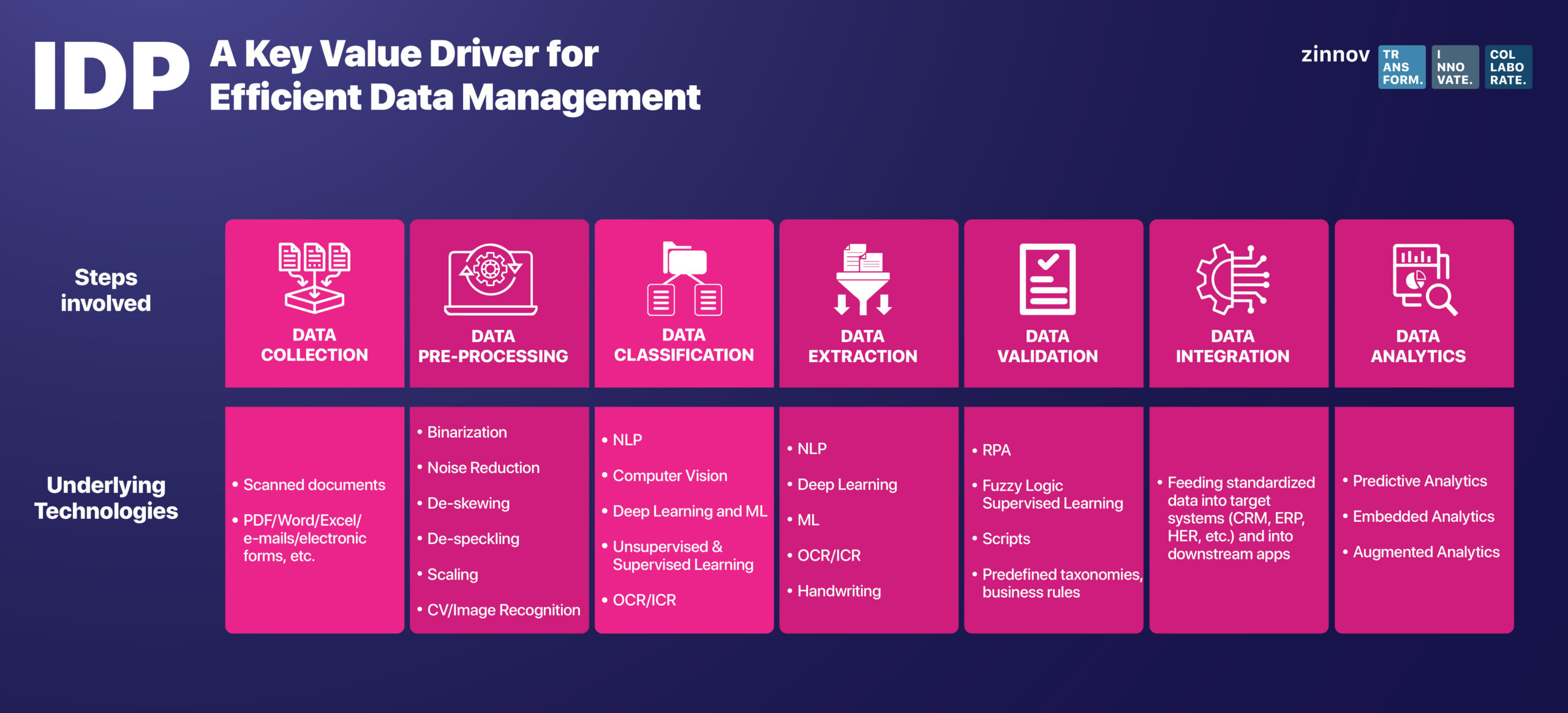|
|
Today more than ever, enterprises are tasked with automating their document-intensive processes to increase efficiency and improve data-driven customer experience, whether it’s medical claims or loan processing. Intelligent Document Processing (IDP) has been in existence for a long time in many different avatars. From Optical Character Recognition (OCR), Advanced OCR, the influx of technologies, including Natural Language Programming (NLP), and Natural Language Generation (NLG), which eventually culminated into IDP platforms. In fact, our analysis of Fortune 250 enterprises 2021, reveals that there are 119 IDP platforms with a 48% market share in the Hyper Intelligent Automation (HIA) ecosystem, growing at 65% year-on-year, compared to 72 IDP platforms in 2020.
To understand the role of IDP within HIA, the technological advancements within IDP, and to understand Parascript’s unique approach of ‘Smart Learning,’ that enables it to offer extensive coverage across numerous use cases – Nischay Mittal, Principal & Global Head – Automation/AI, Zinnov, Vansh Kukreja, Project Lead, and Anudeep Gill, Consultant, Zinnov, caught up with Greg Council, Vice President Marketing and Product Management, Parascript, for an insightful conversation. We also gathered his thoughts around a few critical use cases and his take on the multi-platform strategy that a few enterprises are leveraging.

Here is an excerpt from the interview:

The progression of Automation technologies has grown significantly. Let us look at it as a capability maturity model along with the progression of technology, to where it started as a very basic conversion of documents that are searchable and editable. There is immense interest around the interpretation of documents, and it’s not just the conversion of unstructured data into structured data. We are leveraging that information to apply new capabilities to data for interpretation, to drive new use cases.
IDP has become more strategic because every organization’s goal is to become paper-free, but that does not translate into becoming document-free. For instance, the Health Insurance industry has a process called ‘Prior Authorization,’ where often, the healthcare providers and physicians are required to submit a request for approval for payments, regarding certain procedures. A decent percentage of these repeatable processes can be automated. For example, anytime a process involves a complex document, such as a medical record, these repetitive processes such as waiting for someone to identify the attachment, finding someone to review it, and more, can come to a halt. Given that delays in prior authorization approvals impact treatment, the bottlenecks are very visible to the C-suite leading to the adoption of Automation technology for a faster turnaround to meet deadlines. There are plenty of other examples where the need to access and review document-based information exists and the pain associated with it is highly visible.

I think there are several innovations, but I would like to focus on two especially:
Parascript is investing heavily in these two areas to simultaneously expand the range of use cases that IDP can support, while reducing the overall complexity so that organizations of all sizes can benefit, regardless of the technical wherewithal.

There’s nothing inherently wrong with templates. They work very well for structured forms. The problem arises when organizations wish to apply IDP to more complex, higher variance documents, as there is no way to predefine where the needed data is located. So, a library of templates, along with the use of other techniques makes a lot of sense. The real issue though is, how to gauge the performance in terms of its ability to locate and extract as much information as possible into a structured format, with the highest level of accuracy.
Currently, we see there are plenty of templates available off the shelf as pre-built projects. They are often what we call, ‘functionally developed,’ which means they provide the support for the data and have some level of algorithms or parameterization. However, they are not designed to achieve a high level of performance or precision.
We discovered that the only way to deliver high levels of performance is with a very constrained model or scope of requirements. And that’s where Smart Learning came into play. A Smart Learning platform can automate the creation of templates and ML models, and offers a high degree of precision. Its purpose is to not force a choice between templates or more-tolerant alternatives. Rather, through an analysis of training sets, it applies the best approach to optimize performance. There are definitive examples where templates and other ML techniques are used simultaneously on the same document type.
We want to deliver the best of both worlds to our clients.


We certainly see that there is a predominant focus on the desire to have high levels of data accuracy. I don’t think that any organization is going to accept 99.9% accuracy of data if they are able to get only 2% of data out of their system. So, it is a combination of both – maximizing the amount of data one can get out of the system and at the highest level of accuracy. This is still a worthwhile goal that every vendor is striving to optimize for, in terms of meeting customer expectations. To move from a transactional scheme to one based more on outcomes, enterprises need vendors to prove real-world performance prior to purchase. Only then can organizations feel comfortable with a win-win arrangement with their vendor of choice, focused on actual delivered value.

It depends on the nature of the organization and their ability to support one or the other. Many IDP vendors are well-funded, with significant capabilities and access to a significant number of resellers. Each of these resellers can specialize in different verticals. However, most resellers, are sticking to their focus to go down the horizontal path to provide various platform offerings.
Let us consider the strategy of offering a few pre-built templates for different use cases. For instance, players like ABBYY and large Cloud-based vendors like Google, Amazon, and Microsoft offering the general capabilities of an IDP platform. All of this requires some subject matter expert to fit that general platform into more of a verticalized type of solution. A good strategy is to focus on the areas where the purpose is to build the best, complete capabilities for specific verticals and more specific business processes within those verticals.
We are identifying and targeting specific use cases that require specialization, but at the same time, do not need the same levels of huge investment as a generalized approach. I think we will continue to see a bifurcation of solutions into the two buckets: general IDP platforms by well-funded companies and specialist IDP by niche players.

Well, the education of the market is always a challenge as there are several organizations that just don’t understand the technology right. Therefore, most of the enterprises are starting from a very novice position, to try to accelerate their knowledge. To educate organizations, we have created a construct that will help them understand the right business processes for Automation within the IDP software. Using this tool, organizations can plot out all their processes by key attributes that allow them to identify where IDP can drive the greatest benefit.
Often, organizations spend too much focus on high document volumes. We are not only focusing on the volume of documents but also on the value of the staff engaged in these document-oriented processes. As I mentioned, there is the traditional focus on processes with high document volumes where there is a large number of staff focused on performing various tasks such as document preparation and data entry. Following this path, the focus is mostly on larger organizations with large operations. Generally, large organizations would outsource this type of work. Less understood or appreciated are the lower volume processes that are high-value/high-cost, due to either the complexity of the process itself or due to the highly compensated staff that are involved. Therefore, we are educating our existing clients and prospects to look beyond document volumes and focus on the nature of documents and the overall cost.

I love your observation on the co-opetition versus competition aspect. Organizations do not want to manage the variety of vendor relationships, either from a procurement perspective or deployment perspective. I think this advent of marketplaces that the larger vendors are deploying is a perfect example of how you can have co-opetition. We collaborated with Automation Anywhere to make our technology capabilities available to their reseller network in their end-user organizations.
Similarly, for Cloud vendors, we can offer our skills as part of their Cloud capabilities and position them either as complimentary or directly competitive against, say a Google’s document classification capability. This allows for the proliferation of the best of breed, but with an ecosystem based around a large vendor, allowing the user to almost get the best of both worlds.
We live in a data-driven world that is often complex and requires decoding. Hence, humans are removing tedious and repetitive processes by incorporating Automation and unlocking true value for their organizations. Implementing IDP, which can process complex document-based information in bulk and at the highest accuracy levels, will help enhance business efficiency, transform existing processes, and achieve Intelligent Automation success.